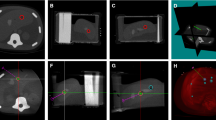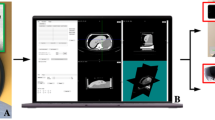Abstract
Objective
A smartphone augmented reality (AR) application (app) was explored for clinical use in presurgical planning and lesion scalp localization.
Methods
We programmed an AR App on a smartphone. The accuracy of the AR app was tested on a 3D-printed head model, using the Euclidean distance of displacement of virtual objects. For clinical validation, 14 patients with brain tumors were included in the study. Preoperative MRI images were used to generate 3D models for AR contents. The 3D models were then transferred to the smartphone AR app. Tumor scalp localization was marked, and a surgical corridor was planned on the patient’s head by viewing AR images on the smartphone screen. Standard neuronavigation was applied to evaluate the accuracy of the smartphone. Max-margin distance (MMD) and area overlap ratio (AOR) were measured to quantitatively validate the clinical accuracy of the smartphone AR technique.
Results
In model validation, the total mean Euclidean distance of virtual object displacement using the smartphone AR app was 4.7 ± 2.3 mm. In clinical validation, the mean duration of AR app usage was 168.5 ± 73.9 s. The total mean MMD was 6.7 ± 3.7 mm, and total mean AOR was 79%.
Conclusions
The smartphone AR app provides a new way of experience to observe intracranial anatomy in situ, and it makes surgical planning more intuitive and efficient. Localization accuracy is satisfactory with lesions larger than 15 mm.






Similar content being viewed by others
Abbreviations
- 2D:
-
Two-dimensional
- 3D:
-
Three-dimensional
- AR:
-
Augmented reality
- MRI:
-
Magnetic resonance imaging
- DICOM:
-
Digital Imaging and Communications in Medicine
- App:
-
Application
- SLAM:
-
Simultaneous localization and mapping
- MMD:
-
Max-margin distance
- AOR:
-
Area overlap ratio
References
Atherton S, Javed M, Webster S, Hemington-Gorse S (2013) Use of a mobile device app: a potential new tool for poster presentations and surgical education. J Vis Commun Med 36(1–2):6–10
Chen J, Han K, Zhang D, Li Z, Hou L (2017) Presurgical planning for supratentorial lesions with free Slicer software and Sina app. World Neurosurg. https://doi.org/10.1016/j.wneu.2017.06.146
Cho J, Rahimpour S, Cutler A, Goodwin CR, Lad SP, Codd P (2020) Enhancing reality: a systematic review of augmented reality in neuronavigation and education. World Neurosurgery 139:186–195
Eftekhar B (2015) A smartphone app to assist scalp localization of superficial supratentorial lesions – Technical note. World Neurosurg. https://doi.org/10.1016/j.wneu.2015.09.091
Rae E, Lasso A, Holden MS, Morin E, Levy R, Fichtinger G (2018) Neurosurgical burr hole placement using the Microsoft HoloLens. Medical Imaging. https://doi.org/10.1117/12.2293680
Frantz T, Jansen B, Duerinck J, Vandemeulebroucke J (2018) Augmenting Microsoft’s HoloLens with vuforia tracking for neuronavigation. Healthc Technol Lett 5(5):221–225
Hou Y, Ma L, Zhu R, Chen X, Zhang J (2016) A Low-cost iPhone-assisted augmented reality solution for the localization of intracranial lesions. PLoS ONE 11(7):e0159185. https://doi.org/10.1371/journal.pone.0159185
Incekara F, Smits M, Dirven C, Vincent A (2018) Clinical feasibility of a wearable mixed-reality device in neurosurgery. World Neurosurgery 118:e422–e427. https://doi.org/10.1016/j.wneu.2018.06.208
Lebel K, Boissy P, Nguyen H, Duval C (2017) Inertial measurement systems for segments and joints kinematics assessment: towards an understanding of the variations in sensors accuracy. BioMed Eng OnLine 16(1):56
Li Y, Chen X, Wang N (2019) A wearable mixed-reality holographic computer for guiding external ventricular drain insertion at the bedside. J Neurosurg 131(5):1599–1606
Mahmoud N, Grasa ÓG, Nicolau SA (2017) On-patient see-through augmented reality based on visual SLAM. Int J CARS 12(1):1–11
Mandel M, Amorim R, Paiva W, Prudente M, Teixeira M, Andrade A (2013) 3D Preoperative planning in the ER with OsiriX®: when there is no time for neuronavigation. Sensors 13(5):6477–6491
Meulstee JW, Nijsink J, Schreurs R (2019) Toward holographic-guided surgery. Surg Innov 26(1):86–94
Nguyen NQ, Cardinell J, Ramjist JM (2020) An augmented reality system characterization of placement accuracy in neurosurgery. J Clin Neurosci 72:392–396
Pelargos PE, Nagasawa DT, Lagman C (2017) Utilizing virtual and augmented reality for educational and clinical enhancements in neurosurgery. J Clin Neurosci 35:1–4
Rodby KA, Turin S, Jacobs RJ (2014) Advances in oncologic head and neck reconstruction: Systematic review and future considerations of virtual surgical planning and computer aided design/computer aided modeling. J Plast Reconstr Aesthet Surg 67(9):1171–1185
Sun G, Chen X, Hou Y (2017) Image-guided endoscopic surgery for spontaneous supratentorial intracerebral hematoma. J Neurosurg 127(3):537–542
van Doormaal TPC, van Doormaal JAM, Mensink T (2019) Clinical accuracy of holographic navigation using point-based registration on augmented-reality glasses. Operative Neurosurgery 17(6):588–593
Weichelt B, Heimonen T, Pilz M, Yoder A, Bendixsen C (2019) An argument against cross-platform development: lessons from an augmented reality App prototype for rural emergency responders. JMIR Mhealth Uhealth 7(3):e12207. https://doi.org/10.2196/12207
Author information
Authors and Affiliations
Corresponding author
Ethics declarations
Ethical approval
The study was approved by the PLA General Hospital Ethics Committee, and informed consent was obtained from all patients.
Conflict of Interest
The authors declare that they have no conflict of interest.
Additional information
Publisher's note
Springer Nature remains neutral with regard to jurisdictional claims in published maps and institutional affiliations.
This article is part of the Topical Collection on Brain Tumors
Supplementary Information
Below is the link to the electronic supplementary material.
Supplementary file1 (MP4 155056 KB)
Rights and permissions
About this article
Cite this article
Shu, Xj., Wang, Y., Xin, H. et al. Real-time augmented reality application in presurgical planning and lesion scalp localization by a smartphone. Acta Neurochir 164, 1069–1078 (2022). https://doi.org/10.1007/s00701-021-04968-z
Received:
Accepted:
Published:
Issue Date:
DOI: https://doi.org/10.1007/s00701-021-04968-z




